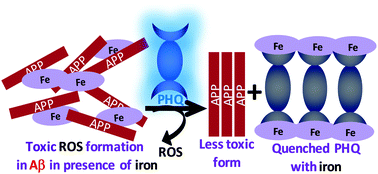In their study, Iyer and co-workers synthesized a non toxic conjugated polymer, poly(1,4-bis-(8-(8-hydroxyquinoline)-octyloxy)-benzene) (PHQ), able to bind iron containing heme and non-heme proteins, such as ferritin, at nanomolar levels with the highest known selectivity in cerebrospinal fluid (CSF). It has been employed to interact with the bound iron, including non-heme ferritin, in the Ab protofibril aggregates and to diminish their accumulation. The anti-AD activity of PHQ was confirmed via in vitro control studies by doping CSF of healthy individuals with Ab(1–40) with and without iron using a Thioflavin-T binding assay test and electron microscopy analysis. This new strategy to clear the cerebral deposits using conjugated polymers enables the toxic aggregated Ab peptide fibrils present in the CSF to be successfully disrupted under physiological conditions.
A rapid and sensitive detection of ferritin at a nanomolar level and disruption of amyloid β fibrils using fluorescent conjugated polymer by B. Muthuraj, Sameer Hussain and Parameswar Krishnan Iyer, Polym. Chem. 2013, 4, 5096-5107 .
Julien Nicolas is a guest web-writer and advisory board member for Polymer Chemistry. He currently works at Univ. Paris-Sud (FR) as a CNRS researcher.











